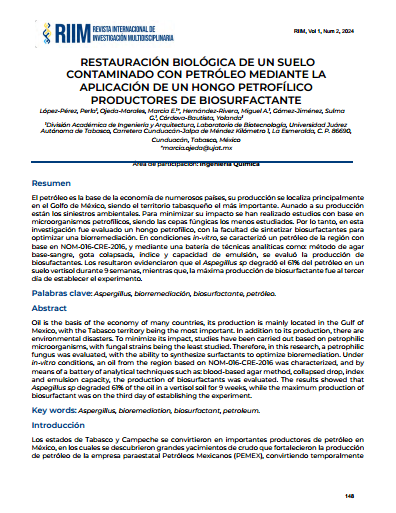Restauración biológica de un suelo contaminado con petróleo mediante la aplicación de un hongo petrofílico productores de biosurfactante
Keywords:
Aspergillus, Bioremediation, BiosurfactantAbstract
Oil is the basis of the economy of many countries, its production is mainly located in the Gulf of Mexico, with the Tabasco territory being the most important. In addition to its production, there are environmental disasters. To minimize its impact, studies have been carried out based on petrophilic microorganisms, with fungal strains being the least studied. Therefore, in this research, a petrophilic fungus was evaluated, with the ability to synthesize surfactants to optimize bioremediation. Under in-vitro conditions, an oil from the region based on NOM-016-CRE-2016 was characterized, and by means of a battery of analytical techniques such as: blood-based agar method, collapsed drop, index and emulsion capacity, the production of biosurfactants was evaluated. The results showed that Aspegillus sp degraded 61% of the oil in a vertisol soil for 9 weeks, while the maximum production of biosurfactant was on the third day of establishing the experiment.
References
Á. V. Rabelo Avalos, D. E. Ramos Muñoz, M. Á. Díaz Perera y M. A. Mesa Jurado, «El petróleo en Tabasco: propuesta para una periodización,» Scielo, vol. 83, nº 1, pp. 129-155, 2021, doi: https://doi.org/10.22201/iis.01882503p.2021.1.60025.
M. d. R. Cantañeda-Chávez, E. Díaz-Torres, J. V. Megchún-García y A. García-Saldaña, «Hydrocarbons and heavy metals in Macuspana, Tabasco, Mexico: key stakeholders,» Research in Agricultural & Applied Economics, vol. 14, nº 5, pp. 113-120, 2021, doi: 10.22004/ag.econ.313414.
C. M. Morales-Bautista, C. E. Lobato-García, J. Flores Jiménez y C. Méndez-Olán, «Cambios en las propiedades físicas y químicas de un suelo debido a un proceso de restauración aplicado a un derrame de hidrocarburos,» Scielo, vol. 29, nº 1, pp. 1-14, 2019, doi: https://doi.org/10.15174/au.2019.2154.
S. Ruíz Liévano, «La responsabilidad del daño ambiental por derrame de hidrocarburos en suelos en Tabasco, México,» Revista Ciencias y Humanidades, vol. XIV, nº 14, pp. 135-160, 2022, doi: https://oaji.net/articles/2022/11095-1659451910.pdf.
S. Mahima, «An inclusive evaluation of soil pollution and remediation by chemical, physical and biological methods,» Internatinal Journal of Chemical Studies, vol. 12, nº 4, pp. 5-17, 2024.
J. Ugaz-Hoyos, H. Vega Cruz, S. Iglesias Osores y C. Careño-Farfán, «Biosurfactants in the bioremediation of hydrocarbon-contaminated soils,» Scielo Preprintes, vol. 1, 2020, doi: https://doi.org/10.1590/scielopreprints.642.
A. M. Bohórquez Rodríguez y O. Castiblanco Urrego, «Revisión del uso de biosurfactantes para su implementación en los procesos de recuperación mejorada de petróleo,» Inventum. Ingenieria, Tecnologia e Investigacion, vol. 16, nº 31, pp. 4-14, 2021, doi: 10.26620/uniminuto.inventum.16.31.2021.4-14.
J. Ahmad, N. Marsidi, S. R. Sheikh Abdullah, H. Abu Hasan, A. R. Othman, N. ´. Ismail y C. B. Kurniawan, «Integrating phytoremediation and mycoremediation with biosurfactant-producing fungi for hydrocarbon removal and the potential production of secondary resources,» Chemosphere, vol. 349, 2024, doi: https://doi.org/10.1016/j.chemosphere.2023.140881.
U. Odili, F. Ibrahim, E. Shaibu-Imodagbe y H. Atta, «Comparative Assessment of Crude Oil Degradation by Monocillium sp. and Aspergillus niguer,» Journal of Applied Sciences and Environmental Management, vol. 25, nº 5, pp. 815-820, Mayo 2020, doi: https://dx.doi.org/10.4314/jasem.v24i5.13.
A. Maamar, M. E. Lucchesi, S. Debaets, N. Nguyen Van Long, M. Quemener, E. Coton, M. Bouderbala, G. Burgaud y A. Matallah-Boutiba, «Highlighting the Crude Oil Bioremediation Potential of Marine Fungi Isolated from the Port of Oran (Algeria),» Diversity, vol. 12, nº 5, pp. 1-19,
, doi: https://doi.org/10.3390/d12050196.
Comisión Reguladora de Energía, «NOM-016-CRE-2016. Especificaciones de calidad de los petrolíferos,» 29 08 2016.
M. T. Madigan, K. S. Bender, D. H. Buckeley, W. M. Sattley y S. A. Stahl, Brock Biology of Microorganisms, Pearson Education, 2021.
R. Torres-Custodio, M. Á. Hernández-Rivera, J. D. l. S. López-Lázaro, Y. Córdova-Bautista, J. G. Álvarez-Ramírez, P. Sifuentes-Gallardo y M. E. Ojeda-Morales, «Extraction and characterization of a biosurfactant synthesized by Acinotebacter baumannii,» Mexican Journal of Biotecnnology,
vol. 8, nº 1, pp. 37-65, 2023, doi: https://doi.org/10.29267/mxjb.2023.8.1.37.
E. W. Koneman, G. W. Procop, D. L. Church, G. S. Hall, W. M. Janda, P. C. Schreckenberger y G. L. Woods, Color Atlas & Textbook of Diagnostic Microbiology, 7 ed., Wolters Kluwer, L'Hospitalet de Llobregat, 2017.
D. J. Palma-López, R. Jiménez-Ramírez, J. Zavala-Cruz, F. Bautista-Zúñiga, F. Gavi-Reyes y D. Y. Palma-Cancino, «Actualización de la clasificación de suelos de Tabasco, México,» AGOPRODUCTIVIDAD - Colegio de Posgraduados, vol. 10, nº 12, pp. 29-35, 2017. [16] SEMARNAT, «NOM-138-SEMARNAT/SSA1-2012, Límites máximos permisibles de hidrocarburos en suelos y lineamientos para el muestreo en la caracterización y especificaciones para la remediación,» 2013.
D. P. Cassidy y A. J. Hudak, «Microorganism selection and biosurfactant production in a continuously and periodically operated bioslurry reactor,» Journal of Hazardous Materials, vol. 84, nº 2, pp. 253-264, 2001, doi: https://doi.org/10.1016/S0304-3894(01)00242-4.
«NMX-AA-134-SCFI-2006. SUELOS – HIDROCARBUROS FRACCIÓN PESADA POR EXTRACCION Y GRAVIMETRIA – MÉTODO DE PRUEBA,» 2006.
«NOM-111-SSA1-1994, Bienes y servicios. Método para la cuenta de mohos y levaduras en alimentos.,» 1995.
M. A. Al.Dossary, S. A. Abood y H. T. A. Al-Saad, «Biodegradation of Crude Oil Using Aspergillus species,» Journal of Biology, Agriculture and Healthcare, vol. 9, nº 4, pp. 60-64, 2019,doi: 10.7176/JBA.
A. M. Ahmed El-Bondkly y M. M. A. Ahmed El-Gendy, «Bioremoval of some heavy metals from aqueous solutions by two different indigenous fungi Aspergillus sp. AHM69 and Penicillium sp. AHM96 isolated from petroleum refining wastewater,» Heliyon, vol. 8, pp. 1-16, 2022, doi:
https://doi.org/10.1016/j.heliyon.2022.e09854.
M. Asgher, S. Arshad, S. A. Qamar y N. Khalld, «Improved biosurfactant production from Aspergillus niger through chemical mutagenesis: characterization and RSM optimization,» discover Applied Sciences, vol. 2, nº 966, pp. 1-11, 2020, doi: https://doi.org/10.1007/s42452-020-2783-3.
A. H. Khan y S. Tanveer, «Biosurfactant-producing Aspergillus, Penicillium, and Candida Performed Higher Biodegradation of Diesel Oil than a Non-producing Fungal Strain,» ApplBiochem Microbiol, pp. 282-289, 2023, doi: https://doi.org/10.1134/S0003683823030109.







